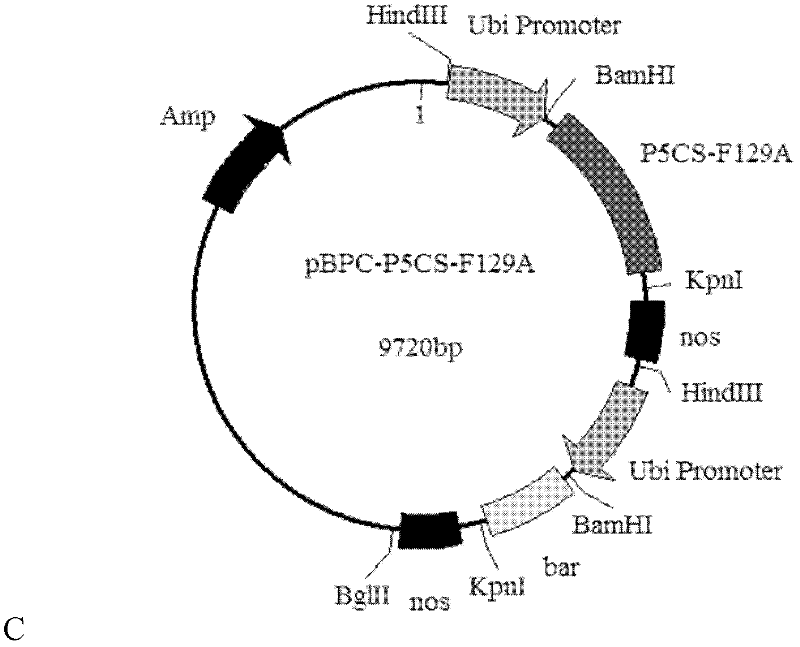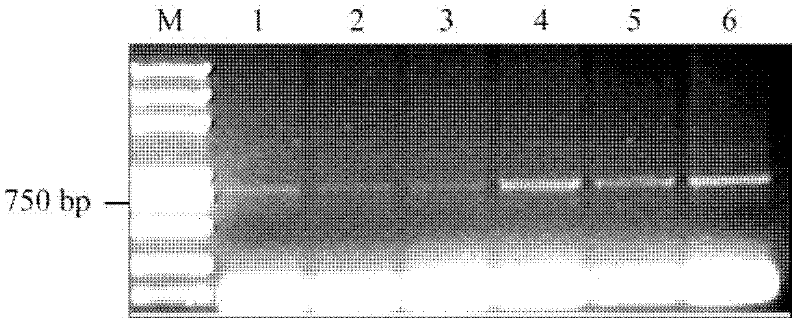Application of Cre/loxP recombinant enzyme system in transgenic breeding of chrysanthemum
A transgenic and recombinase technology, used in applications, recombinant DNA technology, angiosperms/flowering plants, etc.
- Summary
- Abstract
- Description
- Claims
- Application Information
AI Technical Summary
Problems solved by technology
Method used
Image
Examples
Embodiment 1
[0026] Embodiment 1Pksb-rd29A-Cre / lox plant expression vector construction
[0027] First, the promoter rd29A was amplified from Arabidopsis thaliana by PCR, digested with XbaI and BamHI, and connected with the large fragment of the intermediate vector pUC18 also digested with XbaI and BamHI to obtain the intermediate vector pUC18-rd29A. The target gene Cre was amplified by PCR from the pCre plasmid, and double-digested with NcoI and PstI. At the same time, pUC18-rd29A was double-digested with NcoI and PstI, ligated to obtain the intermediate vector pUC18-rd29A-Cre, and then PCR was used to obtain the Puc18 -The rd29A-Cre-nos reading frame sequence was amplified from the rd29A-Cre vector, and double-digested with SacI and StuI, and connected with the expression vector pksb that was also double-digested with SacI and StuI to obtain a plant expression vector that eliminated the selectable marker system Pksb-rd29A-Cre / lox.
[0028] (1) PCR amplification of rd29A promoter
[002...
Embodiment 2
[0037] Example 2 The acquisition of gene gun-mediated transgenic chrysanthemums
[0038] 1. Pre-cultivation of explants
[0039] Select the upper young leaves, middle leaves and lower old leaves of the aseptic chrysanthemum seedlings of 'Beilinhuang' which are relatively consistent in size and nutritional growth for about 30 days, cut them into small pieces, and put them in MS+0.2mol / L sorbitol+0.2mol / L Mannitol hyperosmotic medium cultured for 12h.
[0040] 2. Gold powder and bullet preparation
[0041] The preparation of particle bullets refers to the method of Sanford et al.
[0042] Preparation of gold powder suspension:
[0043] 1) Weigh 30 mg of gold powder particles with a diameter of 1.0 μm into a 1.5 mL centrifuge tube.
[0044] 2) Add 1 mL of absolute ethanol, vortex for 3-5 minutes, let stand for 15 minutes, and centrifuge at 15000 rpm for 5 minutes.
[0045] 3) Carefully remove the supernatant, add 1 mL of sterile distilled water, vortex fully for 1 min, let s...
Embodiment 3
[0070] The PCR detection of embodiment 3 transgenic plants
[0071] (1) Chrysanthemum genomic DNA extracted by CTAB method
[0072] A. Cultivate the chrysanthemum seedlings in dark for 2-3 days before extraction to reduce the content of starch in the material;
[0073] B. Cut the resistant buds and the young leaves of the non-transgenic control chrysanthemum. As for the pre-cooled mortar, pour liquid nitrogen into the powder and quickly grind it into powder. Take an appropriate amount of powder and put it into a pre-cooled 2mL centrifuge tube with a small key. Add 650 μL of preheated 2×CTAB extraction buffer (with 2% mercaptoethanol added in advance), and mix quickly;
[0074] C. Keep warm in a water bath at 65°C for 30-50 minutes. Gently turn it upside down 2-4 times by hand to fully mix the extract and the material;
[0075] D. After cooling the extract to room temperature, add an equal volume of 24:1 chloroform:isoamyl alcohol and mix gently. Centrifuge at 12000rpm for ...
PUM
 Login to View More
Login to View More Abstract
Description
Claims
Application Information
 Login to View More
Login to View More - R&D
- Intellectual Property
- Life Sciences
- Materials
- Tech Scout
- Unparalleled Data Quality
- Higher Quality Content
- 60% Fewer Hallucinations
Browse by: Latest US Patents, China's latest patents, Technical Efficacy Thesaurus, Application Domain, Technology Topic, Popular Technical Reports.
© 2025 PatSnap. All rights reserved.Legal|Privacy policy|Modern Slavery Act Transparency Statement|Sitemap|About US| Contact US: help@patsnap.com



